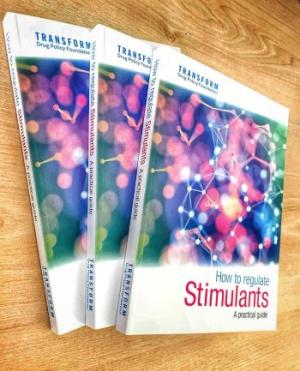How to Regulate Stimulants: A Practical Guide by Steve Rolles, Harvey Slade, and James Nicholls (2020, Transform Drug Policy Foundation, 304 pp., $20 PB)

And now, the good folks at Britain's Transform Drug Policy Foundation are out with a how-to guide for turning that wall into nothing more than a pile of bricks. When it comes to attacking prohibition, marijuana and psychedelics are the low-hanging fruit -- it's easier for members of the public to consider that the harms attributed to their potential abuse or misuse may be far outweighed by the harms of prohibiting them -- but with stimulants such as meth, Ecstasy, and cocaine, the case for prohibition is more popular because the potential harms of their abuse or misuse are much greater.
Still, Steve Rolles and his coauthors make a strong, thoughtful case for dealing with these drugs as we do other non-banned psychoactive substances: Regulating and offering them to consumers with restrictions based on the degree of risk involved. Caffeine is a stimulant, but one with low risk levels for users and society. It is subject only to the regulations of normal commerce -- quality control, informational packaging, and the like.
Coca leaf, coca tea, and oral coca products (lozenges, hard candies, pouches) have a similar risk profile to caffeine -- that is, not much. But both international and US law fail to differentiate between such products with low levels of the cocaine alkaloid and cocaine itself. A regulatory regime based on reason and science would treat coca tea like coffee, not cocaine. But that doesn't mean cocaine would be prohibited.
Indeed, Rolles et al. explicitly differentiate between different forms of stimulants to create a three-tiered regulatory system based not only on science, public health, human rights, but also recognizing the need to prevent corporate takeover and promote social equity. The first tier is the tier of coca tea and coffee.
The second tier, that of medium risk drugs in their typology, produces what they call their "standard model" for dealing with stimulants. Included here are MDMA pills, amphetamine pills (or meth pills -- Desoxyn, anyone?), and cocaine powder. For this tier, they recommend pharmacy-style retail sales at state-owned shops where specially trained druggists dispense not only the dope but also targeted harm reduction information.
And they recommend rationing of these substances, either by purchase amount limits or by means of licensing requirements. The idea is to limit harm by restricting access to these particularly binge-inducing drugs. Rationing is what we do with legal marijuana by restricting purchases, typical to one ounce per day. We don't do that with alcohol, however; you can walk in and buy multiple kegs of beer or cases of hard liquor and no one bats an eye.
Purchase limits -- say one gram of 70% pure powder cocaine per month -- would probably work for most cocaine consumers, who use it recreationally and infrequently. But it wouldn't work for the party host who wants to supply his guests, and more importantly, it wouldn't suffice for the needs of serious drug users, who make up a huge percentage of the sales of any drug.
If the object is to take drug consumers out of the illicit market, rationing is going to have to be flexible enough to address their needs and demands. The authors suggest a tiered system that would allow larger purchases contingent on periodic brief discussions of risks and harm reduction with trained pharmacy vendors.
When it comes to the hardest forms of stimulants, such as injectable meth or cocaine or smokable meth or crack, the model shifts from regulatory retail to harm reduction. The authors advocates measures such as supervised consumption sites and harm reduction kits for crack users. They envision no retail sales of drugs in such forms, but also no criminalization of their users. That might leave users to get their goodies in the black market (or get creative with less harmful forms of the drug, such as converting cocaine powder into crack at home), which could undercut one of the primary rationales for regulation: killing off the illicit market.
But instead of sticks, Rolles et al. offer carrots. Perhaps hardcore tweakers and cokeheads can be induced into using less harmful forms of their drugs of choice, switching from shooting meth to eating oral amphetamines or being offered less-potent powder cocaine formulations with a price incentive. Not discussed is whether users of tier three substances would have some way of obtaining a regulated supply of them through a medical or other non-sales framework.
Regulating stimulant drugs is tricky, with all sorts of different considerations to undertake. But we have a freedom interest, a social justice interest, and a public health interest in moving away from coercive drug prohibition. The Transform Drug Policy Foundation shows us some of the possible paths and is acutely aware of the intricacies of the task. This is very useful stuff. We should all probably send copies of this book to our state and federal elected officials, but not wait for them before starting down the path ourselves.
This work by StoptheDrugWar.org is licensed under Creative Commons Attribution-ShareAlike 4.0 International
Add new comment